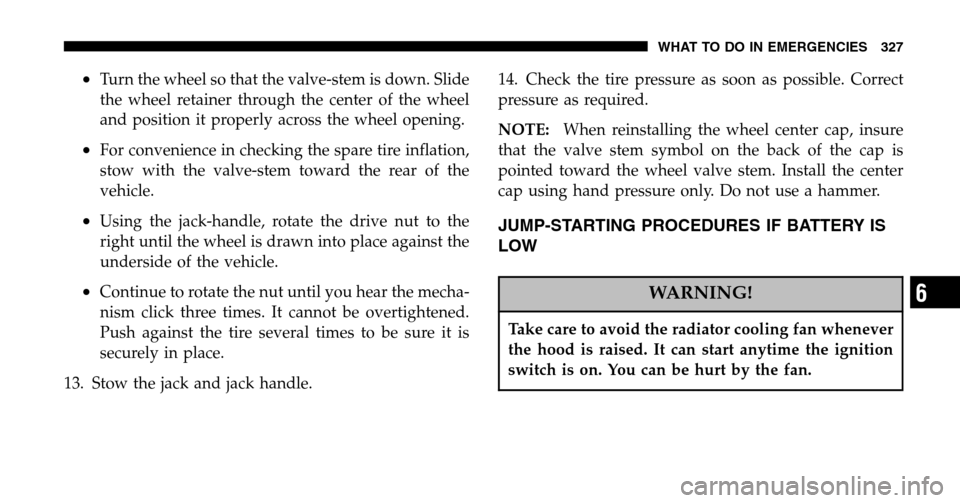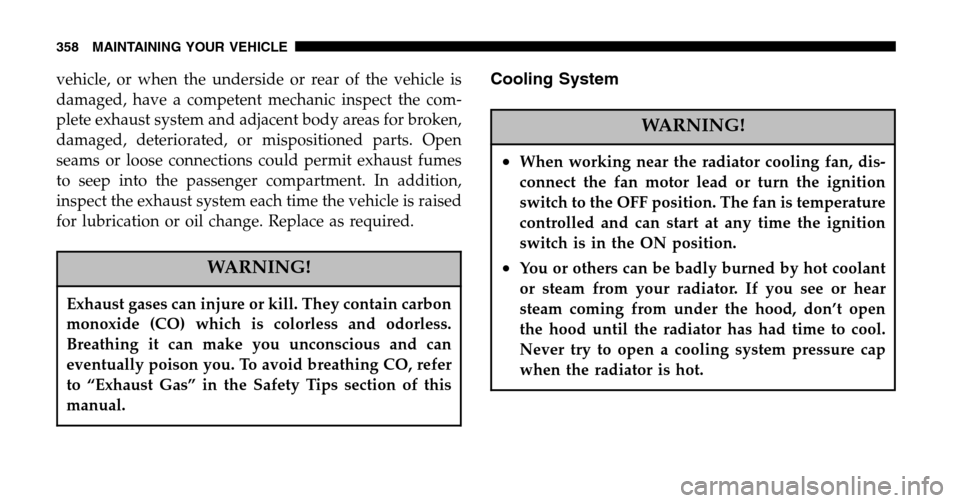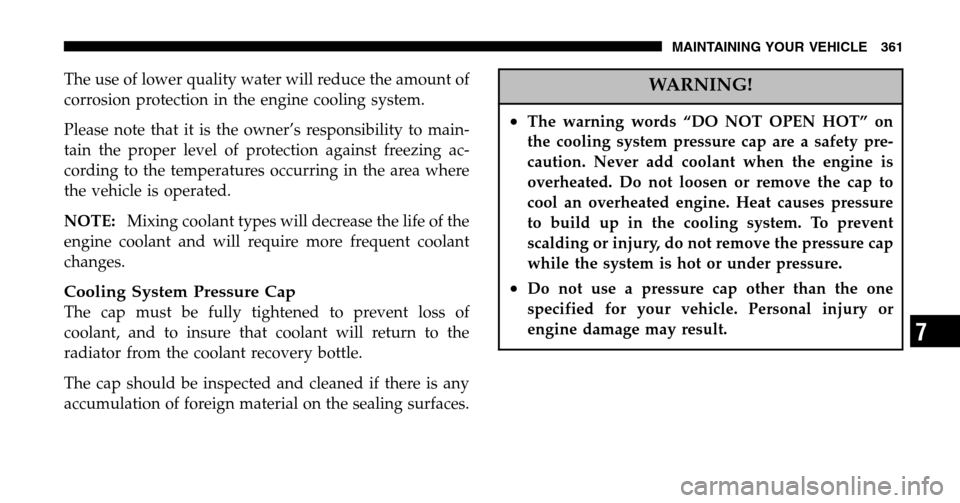2006 CHRYSLER PACIFICA radiator cap
[x] Cancel search: radiator capPage 327 of 440

•Turn the wheel so that the valve-stem is down. Slide
the wheel retainer through the center of the wheel
and position it properly across the wheel opening.
•For convenience in checking the spare tire inflation,
stow with the valve-stem toward the rear of the
vehicle.
•Using the jack-handle, rotate the drive nut to the
right until the wheel is drawn into place against the
underside of the vehicle.
•Continue to rotate the nut until you hear the mecha-
nism click three times. It cannot be overtightened.
Push against the tire several times to be sure it is
securely in place.
13. Stow the jack and jack handle. 14. Check the tire pressure as soon as possible. Correct
pressure as required.
NOTE:
When reinstalling the wheel center cap, insure
that the valve stem symbol on the back of the cap is
pointed toward the wheel valve stem. Install the center
cap using hand pressure only. Do not use a hammer.
JUMP-STARTING PROCEDURES IF BATTERY IS
LOW
WARNING!
Take care to avoid the radiator cooling fan whenever
the hood is raised. It can start anytime the ignition
switch is on. You can be hurt by the fan.
WHAT TO DO IN EMERGENCIES 327
6
Page 358 of 440

vehicle, or when the underside or rear of the vehicle is
damaged, have a competent mechanic inspect the com-
plete exhaust system and adjacent body areas for broken,
damaged, deteriorated, or mispositioned parts. Open
seams or loose connections could permit exhaust fumes
to seep into the passenger compartment. In addition,
inspect the exhaust system each time the vehicle is raised
for lubrication or oil change. Replace as required.
WARNING!
Exhaust gases can injure or kill. They contain carbon
monoxide (CO) which is colorless and odorless.
Breathing it can make you unconscious and can
eventually poison you. To avoid breathing CO, refer
to “Exhaust Gas” in the Safety Tips section of this
manual.
Cooling System
WARNING!
•When working near the radiator cooling fan, dis-
connect the fan motor lead or turn the ignition
switch to the OFF position. The fan is temperature
controlled and can start at any time the ignition
switch is in the ON position.
•You or others can be badly burned by hot coolant
or steam from your radiator. If you see or hear
steam coming from under the hood, don’t open
the hood until the radiator has had time to cool.
Never try to open a cooling system pressure cap
when the radiator is hot.
358 MAINTAINING YOUR VEHICLE
Page 359 of 440

Engine Coolant Checks
Check the engine coolant (antifreeze) protection every 12
months (before the onset of freezing weather, where
applicable). If coolant is dirty or rusty in appearance, the
system should be drained, flushed and refilled with fresh
coolant. Check the front of the A/C condenser for any
accumulation of bugs, leaves, etc. If dirty, clean by gently
spraying water from a garden hose vertically down the
face of the condenser.
Check the coolant recovery bottle tubing for brittle rub-
ber, cracking, tears, cuts and tightness of the connection
at the bottle and radiator. Inspect the entire system for
leaks.
With the engine at normal operating temperature (but
not running), check the cooling system pressure cap for
proper vacuum sealing by draining a small amount of
coolant from the radiator drain cock. If the cap is sealing
properly, the engine coolant (antifreeze) will begin to drain from the coolant recovery bottle. DO NOT RE-
MOVE THE COOLANT PRESSURE CAP WHEN THE
COOLING SYSTEM IS HOT.
Cooling System — Drain, Flush and Refill
At the intervals shown on the Maintenance Schedules,
the system should be drained, flushed and refilled.
If the solution is dirty or contains a considerable amount
of sediment, clean and flush with a reliable cooling
system cleaner. Follow with a thorough rinsing to remove
all deposits and chemicals. Properly dispose of old
antifreeze solution.
Selection Of Engine Coolant
Use only the manufacturers recommended coolant, refer
to Fluids, Lubricants and Genuine Parts for correct
coolant type.
MAINTAINING YOUR VEHICLE 359
7
Page 361 of 440

The use of lower quality water will reduce the amount of
corrosion protection in the engine cooling system.
Please note that it is the owner’s responsibility to main-
tain the proper level of protection against freezing ac-
cording to the temperatures occurring in the area where
the vehicle is operated.
NOTE: Mixing coolant types will decrease the life of the
engine coolant and will require more frequent coolant
changes.
Cooling System Pressure Cap
The cap must be fully tightened to prevent loss of
coolant, and to insure that coolant will return to the
radiator from the coolant recovery bottle.
The cap should be inspected and cleaned if there is any
accumulation of foreign material on the sealing surfaces.
WARNING!
•The warning words “DO NOT OPEN HOT” on
the cooling system pressure cap are a safety pre-
caution. Never add coolant when the engine is
overheated. Do not loosen or remove the cap to
cool an overheated engine. Heat causes pressure
to build up in the cooling system. To prevent
scalding or injury, do not remove the pressure cap
while the system is hot or under pressure.
•Do not use a pressure cap other than the one
specified for your vehicle. Personal injury or
engine damage may result.
MAINTAINING YOUR VEHICLE 361
7
Page 362 of 440

Disposal of Used Engine Coolant
Used ethylene glycol based engine coolant is a regulated
substance requiring proper disposal. Check with your
local authorities to determine the disposal rules for your
community. To prevent ingestion by animals or children
do not store ethylene glycol based engine coolant in open
containers or allow it to remain in puddles on the
ground. If ingested by a child, contact a physician
immediately. Clean up any ground spills immediately.
Engine Coolant Level
The coolant bottle provides a quick visual method for
determining that the coolant level is adequate. With the
engine off and cold, the coolant level in the coolant
recovery bottle should be between the ranges indicated
on the bottle.
The radiator normally remains completely full, so there is
no need to remove the radiator cap unless checking for
coolant freeze point or replacing coolant. Advise your service attendant of this. As long as the engine operating
temperature is satisfactory, the coolant bottle need only
be checked once a month.
When additional coolant is needed to maintain the
proper level, it should be added to the coolant bottle. Do
not overfill.
Points To Remember
NOTE:
When the vehicle is stopped after a few miles (a
few kilometers) of operation, you may observe vapor
coming from the front of the engine compartment. This is
normally a result of moisture from rain, snow, or high
humidity accumulating on the radiator and being vapor-
ized when the thermostat opens, allowing hot coolant to
enter the radiator.
362 MAINTAINING YOUR VEHICLE
Page 423 of 440

Selection Of Lubricant................367,388
Shifting ............................. 263
Special Additives ...................... 370
Automatic Transmission ................... 367
Adding Fluid ......................... 368
Fluid and Filter Changes ................. 369
Fluid Change ......................... 369
Fluid Level Check ...................... 368
Fluid Type ........................... 367
Autostick ........................... 139,264
Ball Joints ............................. 355
Battery ............................... 351
Gas Caution .......................... 352
Jump Starting ......................... 327
Keyless Transmitter Replacement (RKE) ....... 24
Bearings .............................. 372
Belts, Drive ............................ 348
Body Mechanism Lubrication ............... 356 B-Pillar Location
........................ 278
Brake, Parking .......................... 266
Brake System ........................ 268,364
Anti-Lock (ABS) ....................... 269
Fluid Check ....................... 365,388
Hoses .............................. 364
Warning Light ........................ 170
Brakes ............................. 268,364
Brake/Transmission Interlock ............... 261
Break-In Recommendations, New Vehicle ........ 71
Bulb Replacement ....................... 382
Bulbs, Light ............................ 381
Calibration, Compass ..................... 184
Capacities, Fluid ........................ 386
Caps, Filler Fuel ................................ 300
Oil (Engine) ....................... 346,347
Radiator (Coolant Pressure) ............... 361
INDEX 423
10
Page 425 of 440

Adding Coolant (Antifreeze).............. 360
Coolant Capacity ...................... 386
Coolant Level ...................... 359,362
Disposal of Used Coolant ................ 362
Drain, Flush, and Refill .................. 359
Inspection ........................... 362
Points to Remember .................... 362
Pressure Cap ......................... 361
Radiator Cap ......................... 361
Selection of Coolant (Antifreeze) ......359,386,387
Cruise Control (Speed Control) .............. 138
Cruise Light ........................... 173
Cup Holder ......................... 154,376
Customer Assistance ..................... 414
Dealer Service .......................... 343
Defroster, Rear Window ................... 253
Defroster, Windshield ................72,240,249
Delay (Intermittent) Wipers ................. 131 Diagnostic System, Onboard
................ 340
Dimmer Switch, Headlight ................. 130
Dipsticks Automatic Transmission ................. 368
Oil (Engine) .......................... 344
Disabled Vehicle Towing ................... 331
Disarming, Theft System ................... 26
Disposal Antifreeze (Engine Coolant) ............... 362
Engine Oil ........................... 348
Door Ajar Light ......................... 176
Door Locks ............................. 16
Door Locks, Automatic .................... 17
Door Opener, Garage ..................... 142
Drive Belts ............................ 348
Drive Shaft Universal Joints ................ 355
Driving On Slippery Surfaces .................... 329
INDEX 425
10
Page 433 of 440

Mirrors.............................. 82
Outlet (Auxiliary Electrical Outlet) .......... 152
Seats ............................ 106,107
Steering ............................. 271
Steering, Checking ..................... 354
Sunroof ............................. 149
Windows ............................. 32
Pregnant Women and Seat Belts .............. 44
Preparation for Jacking .................... 323
Pretensioners Seat Belts ............................. 42
Programmable Electronic Features ......144,147,179
Programming Transmitters
(Remote Keyless Entry) ...............23,144,147
Radial Ply Tires ......................... 285
Radiator Cap (Coolant Pressure Cap) .......359,361
Radio Broadcast Signals ................... 231
Radio Operation ...................... 207,233 Radio Remote Controls
.................216,229
Radio, Satellite .......................... 225
Radio (Sound Systems) ..............187,197,207
Rear Liftgate ............................ 28
Rear Seating Flexibility .................... 116
Rear Window Defroster ................... 253
Rear Window Features .................... 131
Rear Wiper/Washer ...................... 131
Rearview Mirrors ........................ 79
Reclining Front Seats ..................... 110
Recreational Towing ................... 315,332
Reminder, Seat Belt ....................... 43
Remote Control ......................... 216
Remote Keyless Entry (RKE) ................. 20
Remote Sound System (Radio) Controls ........ 229
Replacement Keys ........................ 14
Replacement Parts ....................... 343
Replacement Tires .................... 289,291
Reporting Safety Defects ................... 417
INDEX 433
10